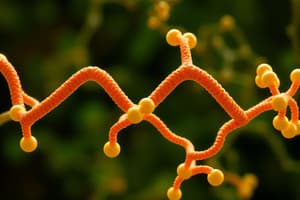Podcast
Questions and Answers
What is the primary mechanism by which hyperuricemia leads to gouty arthritis?
What is the primary mechanism by which hyperuricemia leads to gouty arthritis?
- Inflammation from bacterial infection
- Deposition of monosodium urate crystals (correct)
- Formation of calcium phosphate crystals
- Destruction of joint cartilage
Which diagnostic method is essential for confirming gout?
Which diagnostic method is essential for confirming gout?
- Ultrasound examination of soft tissues
- X-ray imaging of affected joints
- Blood uric acid level measurement
- Synovial fluid aspiration and polarized light microscopy (correct)
What is the main treatment goal for managing gout over the long term?
What is the main treatment goal for managing gout over the long term?
- Promoting the formation of kidney stones
- Increasing dietary purine intake
- Lowering uric acid levels below saturation point (correct)
- Reducing inflammation in the joints
What characterizes patients with Xanthine Oxidase Deficiency (Xanthinuria)?
What characterizes patients with Xanthine Oxidase Deficiency (Xanthinuria)?
What is a life-saving treatment for patients with Adenosine deaminase (ADA) deficiency?
What is a life-saving treatment for patients with Adenosine deaminase (ADA) deficiency?
Which enzyme is specifically inhibited by hydroxyurea in purine metabolism?
Which enzyme is specifically inhibited by hydroxyurea in purine metabolism?
What is the primary role of sulfonamides in medical treatment?
What is the primary role of sulfonamides in medical treatment?
Which condition is characterized by a deficiency in hypoxanthine-guanine phospho-ribosyl transferase (HGPRT)?
Which condition is characterized by a deficiency in hypoxanthine-guanine phospho-ribosyl transferase (HGPRT)?
What is the primary substrate utilized by both adenine phospho-ribosyl transferase and hypoxanthine-guanine phospho-ribosyl transferase?
What is the primary substrate utilized by both adenine phospho-ribosyl transferase and hypoxanthine-guanine phospho-ribosyl transferase?
What is a major pathway for purine salvage in cells?
What is a major pathway for purine salvage in cells?
Which of the following statements is true regarding methotrexate?
Which of the following statements is true regarding methotrexate?
In purine metabolism, what is a characteristic of the salvage pathway?
In purine metabolism, what is a characteristic of the salvage pathway?
What is the primary consequence of Lesch-Nyhan syndrome related to uric acid?
What is the primary consequence of Lesch-Nyhan syndrome related to uric acid?
Which enzyme family is responsible for hydrolyzing nucleic acids in the small intestine?
Which enzyme family is responsible for hydrolyzing nucleic acids in the small intestine?
How does uric acid contribute to tissue healing?
How does uric acid contribute to tissue healing?
What can excessive alcohol consumption lead to regarding uric acid levels?
What can excessive alcohol consumption lead to regarding uric acid levels?
What is the process by which dietary purine bases are primarily converted in intestinal mucosal cells?
What is the process by which dietary purine bases are primarily converted in intestinal mucosal cells?
Which neurological and behavioral symptom is associated with Lesch-Nyhan syndrome?
Which neurological and behavioral symptom is associated with Lesch-Nyhan syndrome?
What role does uric acid play in the body besides being a waste product?
What role does uric acid play in the body besides being a waste product?
Which genetic condition is NOT associated with purine degradation?
Which genetic condition is NOT associated with purine degradation?
What is the main end product of purine nucleotide degradation in humans?
What is the main end product of purine nucleotide degradation in humans?
Which condition is characterized by high uric acid levels in blood due to the underexcretion of uric acid?
Which condition is characterized by high uric acid levels in blood due to the underexcretion of uric acid?
Flashcards are hidden until you start studying
Study Notes
Purine Metabolism
- De novo synthesis is the synthesis of purine nucleotides from simpler precursors.
- Salvage pathway is the recycling of purine bases from the breakdown of nucleic acids.
- Ribonucleotide reductase converts ribonucleoside diphosphates to deoxyribonucleotides, which are essential for DNA synthesis.
- Hydroxyurea inhibits ribonucleotide reductase.
- Thymidylate synthase is involved in pyrimidine synthesis and is inhibited by 5-fluorouracil.
- Dihydrofolate reductase is involved in folate metabolism and is inhibited by methotrexate (eukaryotes), trimethoprim (prokaryotes), and pyrimethamine (protozoa).
- Sulfonamides are structural analogs of para-aminobenzoic acid (PABA).
- Sulfonamides inhibit bacterial synthesis of folic acid by inhibiting dihydropteroate synthase.
- Methotrexate is a structural analog of folic acid used to inhibit nucleotide synthesis in cancer cells.
- Methotrexate inhibits dihydrofolate reductase.
- Adenine phosphoribosyltransferase (APRT) and hypoxanthine-guanine phosphoribosyltransferase (HGPRT) are enzymes involved in the salvage pathway.
- APRT and HGPRT use phosphoribosyl pyrophosphate (PRPP) as a source of ribose 5-phosphate.
- Lesch-Nyhan syndrome is an X-linked recessive disorder caused by a deficiency in HGPRT.
- Lesch-Nyhan syndrome leads to hyperuricemia, gout, urolithiasis, and neurological abnormalities including self-mutilation.
- Hyperuricemia is an elevated level of uric acid in the blood.
- Hyperuricemia can be caused by excessive cell death, alcohol consumption, dietary nucleic acid intake, and underexcretion by the kidneys.
- Gout is a painful inflammatory condition caused by the deposition of monosodium urate crystals in joints.
- Gout is characterized by hyperuricemia.
- Tophi are nodular masses of monosodium urate crystals that can deposit in soft tissues.
- Gout is diagnosed by examining synovial fluid for needle-shaped monosodium urate crystals using polarized light microscopy.
- Gout is treated by lowering uric acid levels below its saturation point.
- Urate oxidase is a potential treatment for gout.
- Hypouricemia is a low level of uric acid in the blood.
- Xanthinuria is a genetic defect caused by a deficiency in xanthine oxidase.
- Xanthinuria leads to hypouricemia and liver damage.
- Adenosine deaminase (ADA) deficiency is an autosomal recessive disorder that leads to a buildup of adenosine and deoxyadenosine.
- ADA deficiency causes severe combined immunodeficiency (SCID).
- SCID involves a decrease in T cells, B cells, and natural killer (NK) cells.
- Treatment for ADA deficiency includes antibiotics, immunoglobulin injections, enzyme replacement therapy (ERT), and bone marrow transplantation (BMT).
Studying That Suits You
Use AI to generate personalized quizzes and flashcards to suit your learning preferences.




